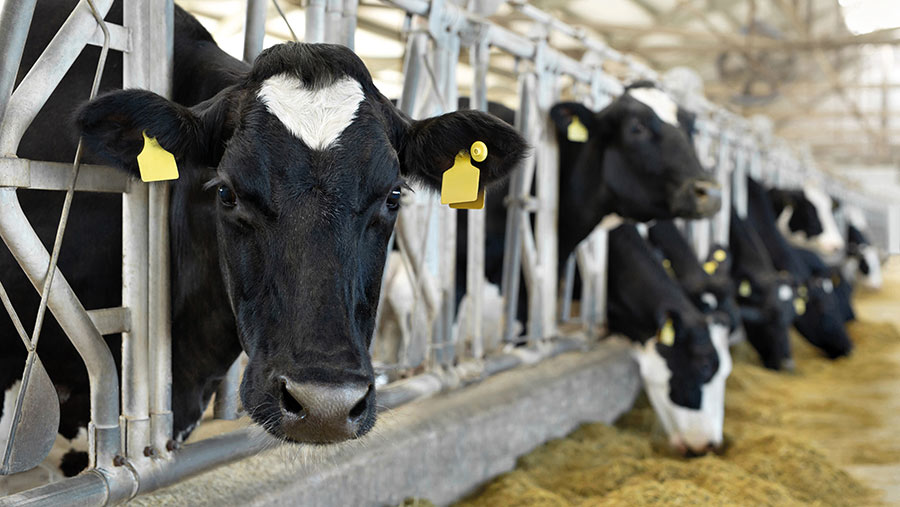Reduction in antibiotics usage has slowed, says survey
 © Artem Zakharov/Adobe Stock
© Artem Zakharov/Adobe Stock Data from more than 1,000 dairy farms revealed that 49% of total antibiotics usage last year took place on just a quarter of farms.
The annual Antimicrobial Focus Report from Kingshay has shown that, while good progress has been made, reduction in antibiotics usage has slowed, so targeted efforts are needed, especially among the higher users.
“Responsible antimicrobial usage is not just an end goal that we get to, it is an ongoing process,” said Tim Potter, Kingshay and Westpoint Farm Vets’ senior clinical director.
See also: How a Dorset dairy farmer cut antibiotics usage by 80%
Average usage for the year ending March 2022 was 15.9mg/kg PCU (population corrected unit)*, very slightly up on the 15.5mg/kg PCU recorded in the 2021 report, but down 27% on four years prior.
That average value was calculated from a range of 0.26-87.17mg/kg PCU across the 1,044 dairy farms surveyed.
Higher users
According to the report, if the highest 25% of antimicrobial users cut their usage by one-third, overall average herd usage would fall to 13.3mg/kg PCU.
That would bring 79% of herds below Kingshay’s 2024 usage target of 17.9mg/kg PCU. Currently, 69% of dairy herds are achieving that figure.
While some farms in the higher quartile have reduced usage year on year, 49% of them were in the higher 25% in 2021 and 2022.
Moreover, 54% of higher-quartile users had increased antimicrobial usage in the 12 months to March 2022.
Injectables
Injection is by far the most used route of antibiotics administration across the board, so this represents the greatest opportunity for reducing antimicrobial usage, according to Dr Potter. On average, 73% of the recorded usage comes from injectable products.
“They are generally used for sick cow management, so there’s real value in people regularly reviewing their treatment protocols with their vets to ensure they are using the right products.
“Regular reviews can also help identify potential management changes such as improvements to buildings, disinfection protocols and nutrition, or the introduction of vaccination programmes that could help reduce the need for antimicrobial treatments in the first place,” he said.
The report authors did not have access to farm treatment records, but Dr Potter said that likely causes of injectable usage would include lameness and post-calving complications.
Dairy lameness and mastitis were highlighted as hotspots for antibiotics use when the Responsible Use of Medicines in Agriculture (RUMA) set its 2024 targets.
The previous Kingshay report suggested that dry cow therapy presented an opportunity for reducing routine antibiotics usage.
Since then, the proportion of herds using teat sealants increased and purchases of antibiotics tubes for both lactating and dry cows decreased.
“We’ve got about 33% of herds this year not using teat sealants, so there is an opportunity there,” said Dr Potter, who believes that the 99 herds from the sample that were not using any antibiotic dry cow tubes at all are a good example of what can be achieved.
Regular review
Dr Potter explained that antibiotics are categorised based upon their importance to human medicine, by the European Medicines Agency. There are four groups:
- The “avoid” category (A) should not be used in food-producing animals at all
- The “restrict” category (B) antibiotics are critically important to human medicine, so use in animals should only be in exceptional circumstances
- The “caution” category (C) includes antibiotics for which there are human alternatives, but they should still only be used if there is nothing suitable available in category D
- The “prudence” category (D) antibiotics should be used prudently, but as the first-line treatment when necessary.
The report showed that usage of antibiotics in category B had been reduced from 3.31% in 2018 to 0.08% in 2022. However, dairy usage is split about 50/50 between category C and D.
“Are there spaces there for farmers to engage with their vet and look at opportunities to move from using antibiotics in category C to antibiotics in category D?” Dr Potter suggested.
Regional variation
Kingshay antimicrobial product owner Christina Ford said there was no correlation between antibiotics usage and herd size, milk yield or cattle breed.
However, regional variation showed that there was higher antimicrobial usage in Scotland, Wales and the north of England.
“More detailed analysis would be needed to understand why these differences appear, but it looks like the northern and Welsh areas have also got lower teat sealant usage compared to the southern regions,” said Ms Ford, drawing a potential link between the two results.
* Measurements recorded in mg/kg PCU (population corrected unit), the unit developed by the European Medicines Agency and used for industry benchmarking.
Farmer checklist for antimicrobial usage progress
The Antimicrobial Focus Report from Kingshay highlighted several ways every dairy farmer can ensure they are optimising management:
- Review disease prevention strategies on farm – look at housing, nutrition, vaccination and protocols.
- Review the treatment plans for specific diseases on farm and check the route of administration (for example, injectable/oral) is the most appropriate and presents a decreased risk of selection for resistance.
- Review youngstock management to minimise the need for oral antibiotics.
- Antimicrobial supply issues caused some farmers to switch to different products, which could be more of a concern when it comes to resistance and human medicine, so switch back if possible.
- If not already using teat sealants, look at how they can reduce antibiotics usage in the herd at drying off.
- Ensure regular vet meetings are scheduled, with time to focus on antibiotics, so that management and treatment protocols remain effective, as farm circumstances constantly change.
- Get a good understanding of antimicrobial resistance and the figures used to record usage. If antibiotics usage becomes a more commonplace discussion, such as cell count, it will help the sector adopt the right mindset.
The full report can be found at Kingshay Antimicrobial Focus Report 2022 – Kingshay
